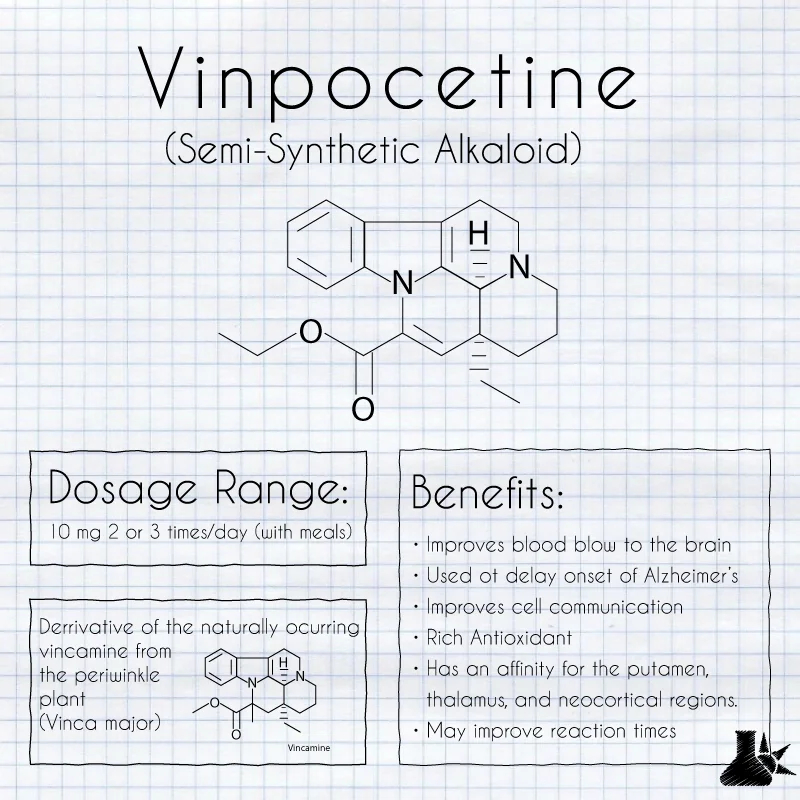What are the benefits of vinpocetine?

Vinpocetine inhibits PDE1 activity and improves cerebral blood flow by elevating cGMP and cAMP, increasing mitochondrial function, and improving glucose and oxygen utilization by the brain. Vinpocetine helps improve spatial memory in rats by preventing neuronal damage and favorably modulating cholinergic function ( 18 ).
Moreover, why is vinpocetine illegal?
Vinpocetine is banned from Australia, New Zealand, and Canada due to potential harmful nootropic characteristics as a cognitive enhancing supplement [1–3]. Keeping this in consideration, what does vinpocetine do in the brain? Vinpocetine is used to enhance memory and increase brain metabolism. It has also been used for ischemia and reperfusion injury, and is considered a neuroprotective agent. However, there are few robust clinical studies to support the use of vinpocetine in stroke, dementia, or other diseases of the CNS.
Also, how long can you take vinpocetine?
Diseases, such as Alzheimer disease, that interfere with thinking (dementia): 5-10 mg of vinpocetine three times daily for up to 4 months. Thereof, is huperzine the same as vinpocetine? Huperzine inhibits AchE, which increases levels of the memory neurotransmitter acetylcholine. Vinpocetine increases cerebral oxygen and concentrations of ATP, and the firing rate of neurons associated with acetylcholine.
What is ginkgo biloba with vinpocetine?
Ginkgo Biloba+Vinpocetine is used in the treatment of cognitive enhancer. Ginkgo Biloba + Vinpocetine is a combination of two medicines: Ginkgo Biloba and Vinpocetine. Ginkgo Biloba increases blood flow to the brain and protects it from damage by harmful chemical substances (free radicals). Is vinpocetine FDA approved? When products like vinpocetine are sold as dietary supplements in the U.S., they have not been reviewed by the FDA under the safety and effectiveness standards that apply to drug products.






Similar articles
- What does vinpocetine do for the brain?
Vinpocetine can be used to improve memory and brain metabolism. Vinpocetine has been used to treat ischemia and reperfusion injuries and is considered a neuroprotective drug. There are not many clinical studies that support vinpocetine's use in stroke, dementia, and other diseases of the CNS.
- What foods contain vinpocetine?
Vinpocetine, a synthetic compound, is derived from vincamine (an alkaloid found in Vinca minor L. plants). Vinpocetine is found in Dietary Supplements Ethyl Apovincaminate. Vinpocetine for Common Periwinkles. Dhul H.
- Does vinpocetine increase dopamine?
Vinpocetine, a nootropic PDE-1 (PDE-1) inhibitor, acts as an indirect dopamine receptor agonist [12]. Pre-treatment with vinpocetine revealed a marked improvement in hyperlocomotion, anxiety, short-term memory and other symptoms in schizophrenia patients [13].
- Is vinpocetine banned?
Vinpocetine is not controlled in the US neutraceutical market. It is commonly used as an active ingredient in dietary supplement products. Vinpocetine is prohibited from Australia, New Zealand and Canada because of its potential nootropic properties as a cognitive-enhancing supplement [1-3].
- What are the benefits of taking astaxanthin?
- What are the benefits of ashwagandha?
- What are the benefits of taking magnesium glycinate?
 Drugs Forum
Drugs Forum
